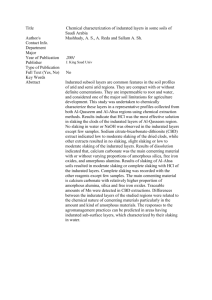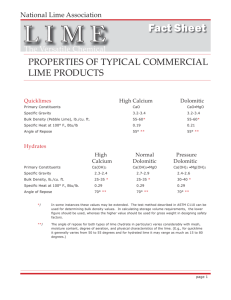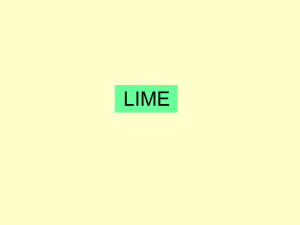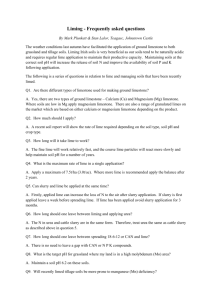An Overview Of Lime Slaking And Factors That Affect The Process
advertisement
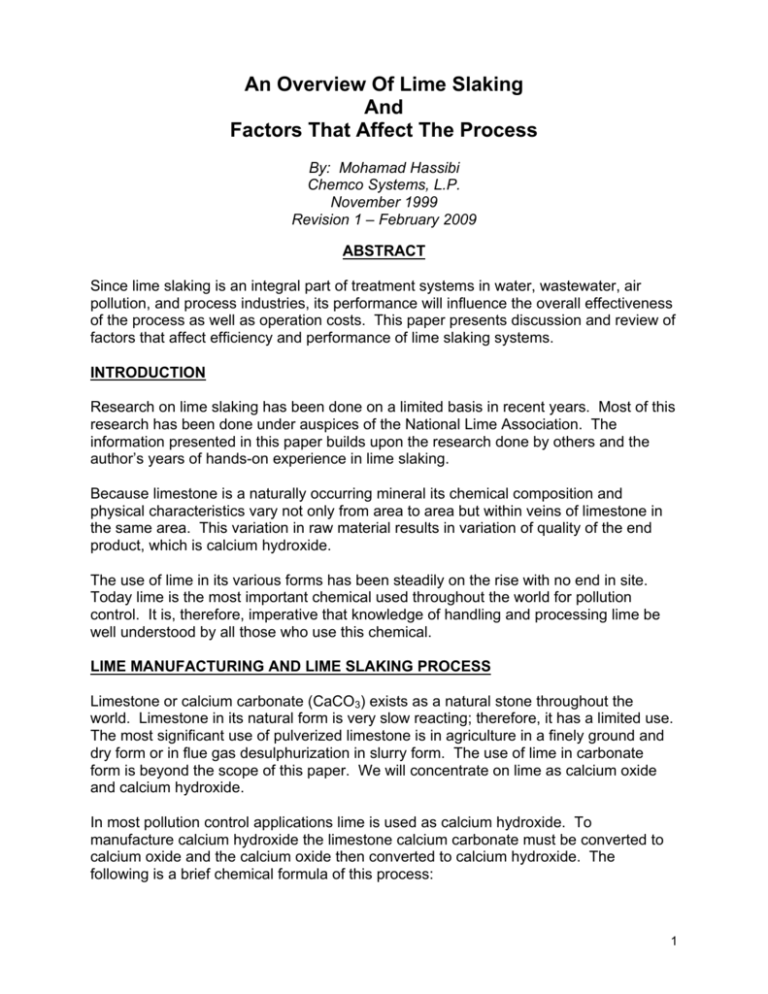
An Overview Of Lime Slaking And Factors That Affect The Process By: Mohamad Hassibi Chemco Systems, L.P. November 1999 Revision 1 – February 2009 ABSTRACT Since lime slaking is an integral part of treatment systems in water, wastewater, air pollution, and process industries, its performance will influence the overall effectiveness of the process as well as operation costs. This paper presents discussion and review of factors that affect efficiency and performance of lime slaking systems. INTRODUCTION Research on lime slaking has been done on a limited basis in recent years. Most of this research has been done under auspices of the National Lime Association. The information presented in this paper builds upon the research done by others and the author’s years of hands-on experience in lime slaking. Because limestone is a naturally occurring mineral its chemical composition and physical characteristics vary not only from area to area but within veins of limestone in the same area. This variation in raw material results in variation of quality of the end product, which is calcium hydroxide. The use of lime in its various forms has been steadily on the rise with no end in site. Today lime is the most important chemical used throughout the world for pollution control. It is, therefore, imperative that knowledge of handling and processing lime be well understood by all those who use this chemical. LIME MANUFACTURING AND LIME SLAKING PROCESS Limestone or calcium carbonate (CaCO3) exists as a natural stone throughout the world. Limestone in its natural form is very slow reacting; therefore, it has a limited use. The most significant use of pulverized limestone is in agriculture in a finely ground and dry form or in flue gas desulphurization in slurry form. The use of lime in carbonate form is beyond the scope of this paper. We will concentrate on lime as calcium oxide and calcium hydroxide. In most pollution control applications lime is used as calcium hydroxide. To manufacture calcium hydroxide the limestone calcium carbonate must be converted to calcium oxide and the calcium oxide then converted to calcium hydroxide. The following is a brief chemical formula of this process: 1 (Limestone) CaCO3 + HEAT (Calcium Oxide) CaO + CO2 However, CaO is unstable in the presence of moisture and CO2. A more stable form of lime is calcium hydroxide Ca(OH)2. (Calcium Oxide) CaO + (Water) H2O Calcium Hydroxide Ca(OH)2 + HEAT The atomic weight of the above formula is: Ca= 40 (40 + 16) 56 + + O= 16 (2+16) 18 H= 1 = + 74 74 Therefore, 56 units of CaO plus 18 units of H2O results in 74 units of Ca(OH)2. The ratio of hydroxide to CaO is 74 ÷ 56 = 1.32. This means that 1 Kg of CaO and 0.32 Kg of water will produce 1.32 Kg of Ca(OH)2, this is the minimum water required for chemical reaction, so calcium hydroxide contains 75.7% CaO and 24.3% H2O. The process of adding water to calcium oxide to produce calcium hydroxide is referred to as hydration process or lime slaking. The hydration of CaO, commercially referred to as quick lime, is an exothermic process releasing a great quantity of heat. This hydration process when done with just the right amount of water is called “Dry Hydration.” In this case the hydrate material is a dry powder. If excess water is used for hydration, the process is called “Slaking.” In this case, the resultant hydrate is in a slurry form. Lime manufacturers generally use the dry hydration process for producing powdered hydrated lime. Our discussion here is limited to lime slaking. The slaking process is normally done with considerable excess water ranging from 2½ parts water to 1 part CaO to 6 parts water to 1 part CaO. EQUIPMENT USED FOR THE SLAKING PROCESS It is not the intent of this paper to evaluate the slaking equipment described below. The intent is to show the types of equipment available for slaking process. There are basically four types of lime slakers available on the market. They are: A. B. C. D. Slurry Detention Slakers Paste Slakers Ball Mill Slakers Batch Slakers A slaker must mix the correct amount of quick lime (CaO) and water, hydrate the quicklime, and separate the impurities and grit from resultant calcium hydroxide slurry. 2 A. SLURRY SLAKERS A slurry slaker generally uses an initial lime to water ratio of 1 to 3.3 to 1 to 5 depending on the make of equipment and quality of CaO and water. Typically, a slurry slaker, sometimes called a detention type slaker, is comprised of two chambers. The first chamber is called the slaking chamber where lime and water are mixed. The second chamber is usually used as a grit removal chamber. The lime slurry flows by gravity from the first chamber to the grit chamber. The slurry viscosity is reduced in the second chamber by the addition of cold water to allow the heavier grit to settle to the bottom of the second chamber where the grit is elevated and discharged by a screw. Figure 1 shows one such slaker. The slurry slakers are generally designed for a retention time of 10 minutes at a full rated capacity. This means that from the time a particle of CaO enters the slaker until it exits into the grit remover takes an average of 10 minutes. Figure 1 Volumetric Rotary Feeder Sample Chute Dust and Vapor Canister Grit Remover Chamber Grit Discharge Slurry Discharge Lime Slurry Heat Exchanger Figure 1. Typical Slaker Flow Pattern. The slurry slakers are available in a variety of sizes ranging from 150lb/hr to 15 tons/hr. Slurry slakers also are available with external vibratory grit separation screens. Slurry or detention type slakers are the most common types in Europe and the USA. 3 B. PASTE SLAKERS Paste slakers, as the name implies, slake the lime into a paste form. The lime to water ratio is generally 1 to 2.5. Paste slakers are compact in size and are designed for a retention time of 5 minutes in the slaking chamber. In a paste slaker, since the hydroxide paste is too heavy to flow by gravity, a pair of horizontal rotating paddles pushes the paste forward toward the discharge point. Once the paste exits the slaking chamber it is diluted to approximately 1 part lime to 4 parts water. This dilution allows grit separation by gravity or by an external vibrating grit screen. The slurry consistency from a paste slaker and a slurry slaker is exactly the same after dilution of grit removal. Paste slakers are available in sizes ranging from 1000lb/hr to 8000lb/hr. Paste slakers are mostly used in the USA. Figure 2 is a graphic depiction of a paste slaker. The grit elevator is not shown in this figure. Figure 2 Lime Feed Cut-off spray Header Gearbox Weir Slaking Chamber Slaking Discharge Chamber Motor Over Flow Pipe Vent Slaked Lime (Slurry) Discharge 4 C. BALL MILL SLAKERS Ball mill slakers are an adaptation of ball mills, which originally were designed for wet and dry grinding, to lime slaking. Two types of ball mills are used for slaking, horizontal and vertical. Ball mill slakers are generally used where: the capacity required is too large for other types of slakers. due to zero discharge conditions at the site, no grit discharge is allowed. the water available is too high in sulfates or sulfites for regular slakers. The ball mill slakers are much more expensive than paste or slurry slakers. They are available in sizes ranging from 1000lb/hr to 50 tons/hr. Figure 3 shows an attritor type vertical ball mill lime slaker. The ball mill slakers are equipped with an external classifier, which separates slurry from the oversized grit and impurities. The oversize grit is recycled back into the mill for regrind. Figure 3 5 D. BATCH SLAKER Batch slakers are a variation of the slurry slaker. They typically work as follows: As the name implies, the operator decides the size of the batch of lime slurry to be made. The controls using the desired batch calculate how much water and lime is needed to make one batch. First, the cold water is a predetermined quantity (volumetrically or gravimetrically) and is added to the batch tank. Then the quicklime is added in a predetermined quantity (volumetrically or gravimetrically) to the batch tank. The lime and water are mixed and agitated until the mixture’s temperature reaches a preset temperature between 170ºF to 180ºF. Once the desired temperature is reached, the resultant slurry is dumped into a second tank for use or grit removal depending on whether a pulverized or pebble quicklime is used. Once the slaking tank is emptied, the water for the next batch is added to the slaking tank and the system goes to a stand-by mode waiting for an operator to start the next batch cycle. Figure 4 shows a batch slaker for use with pulverized quicklime. Batch slakers are used where only a few small batches are needed periodically when a continuous slurry slaker cannot be used. 6 FACTORS AFFECTING THE QUALITY OF CaO As stated previously, the calcium carbonate is heated in the rotary or vertical kilns to drive away CO2 from limestone CaCO3 to produce calcium oxide CaO. This process is called calcination. Calcination conditions highly affect the quality of quicklime CaO that results from this process. The following factors are the major determinants of the quality of CaO: A. B. C. D. Chemical composition of limestone. Temperature of kiln during calcination Residence time of lime in kiln The concentration of CO2 in the kiln atmosphere. A. CHEMCIAL COMPOSITION OF LIMESTONE The chemical composition of the limestone cannot be controlled without a major cost impact on manufacturing; therefore, variation is generally accepted. The calcination temperature should be controlled very closely. To heat the limestone evenly in the kiln, the particle size of feed must be relatively uniform. To avoid long residence time in the kiln, the particle size of limestone must be small, typically about 1 ½”. However, due to the nature of the crushing operation in reality, there is a range in size from ½” to 2”. Since the residence time and temperature in the kiln is constant, the heat penetration in the particles of limestone is different due to the variation of the size of the limestone. As shown in Figure 5, on larger size stone, heat does not quite penetrate to the core, therefore, the center of these pieces remain as calcium carbonate while the outside is converted to CaO. These center cores are referred to as grit. For medium size stone, the heat penetration is complete and the entire stone is converted to CaO. For the smaller stones the heat reaches the core rapidly and the outside layer is overheated forming a hard outer shell where water cannot penetrate, therefore, the slaking process is greatly retarded or prevented. Figure 5 In this illustration, the large and medium size particles are highly reactive. Softburned quicklime and the smaller particles are called hard-burned quicklime. 7 B. KILN TEMPERATURE Kiln temperature affects the quality of CaO produced. The resultant hydroxide produced is from slaking this CaO. Very small particle sizes with large specific surfaces are the most desirable end product from calcium oxide. Figure 6 shows the impact of kiln temperature on particle size, thus surface area, of hydrated particles of CaO. Figure 6 2.0 1.8 1.6 Surface area (m2/g) 1.4 1.2 1.0 0.8 0.6 0.4 0.2 0 1600 (871) 1800 (982) 2000 (1093) 2200 (1316) 2400 (1316) Calcination Temperature °F (°C) Relation of surface area to calcination temperature A soft-burned lime pebble is full of small hair-like cracks where CO2 has escaped from the limestone during the calcination process. When this lime is exposed to water, the water penetrates the cracks in the quicklime pebbles and fills these cavities. The hydration takes place quickly, releasing a lot of heat energy. This heat will boil off the water and generate steam, which makes the particles burst, exposing the inner surfaces to water for further slaking. This process will continue until hydration is complete. 8 C. RESIDENCE TIME The residence time of CaCO3 in the kiln is very critical during the calcination process. It is important that the residence time be as short as possible. However, enough time must be allowed for heat to penetrate the particles of CaCO3 and drive the CO2 out of these particles. Calcination is done either with low temperature and high residence time, or high temperature and low residence time. Each lime manufacturer must balance the time of residence and temperature to suit their system. Figure 7 shows a time/temperature rise graph of a soft-burned, high-reactive lime, which is often used as a gauge of reactivity. As stated before, the quality of limestone as well as the calcination process affects the final hydrate quality. Figure 7 9 D. KILN ATMOSPHERE In addition to kiln temperature and residence time, kiln atmosphere affects the quality of CaO. As the temperature of CACO3 increases the CO2 gas is released and CaO is produced. The CO2 must be vented out of the kiln. The CaO has an affinity to absorb moisture and CO2 then revert back to CaCO3. The effect of this conversion is more pronounced with small particles of CaO versus larger pebbles due to the specific surface of the pebbles. Figure 8 shows a slaking rate of four different limes supplied by different manufacturers. There is a great difference between the reactivity of these limes, the rate of temperature rise, and the time required to complete the slaking process. These variables are dealt with in detail later in this paper. Figure 8 10 FACTORS AFFECTING SLAKING PROCESS The most important single factor that affects the process efficiency of a slaking system is the specific surface area of the particles of calcium hydroxide. The larger the specific surface area of the hydrate, the more surface is available for reaction, therefore, the more efficient the reaction and less consumption of lime. The specific surface of calcium hydroxide varies a great deal based upon the variables that are described below. The typical specific surface of calcium hydroxide ranges between 8,000 to 58,000 Cm2/gr. Empirical data shows that the relationship between the particle size of hydrate and specific surface, even though related, is not linear. Figure 8 shows 10 different limes and their hydrates’ particle size and specific surface. These figures confirm a lack of direct correlation between particle size and specific surface. Figure 9 4 LIME 1 2 3 4 5 6 7 8 9 10 PARTICLE SIZE (MICRONS) 2.9 3.0 2.5 3.4 3.9 2.2 2.2 2.4 2.2 3.1 SPECIFIC SURFACE CM2/gr 110000 110000 9000 7000 9000 7000 5000 7000 6000 12000 The following factors affect slaking efficiency by affecting the specific surface of the calcium hydroxide, directly or indirectly: A. B. C. D. E. F. G. H. I. Type of limestone used in calcination Calcination process to manufacture CaO Slaking temperature Lime to water ratio Degree of agitation during slaking Viscosity of slurry Slaking time Water temperature Air slaking 11 A. TYPE OF LIMESTONE Calcium carbonate deposits are generally not pure. They contain many other elements, such as magnesium, aluminum oxide, and compounds that affect the quality of hydrate produced from their limestones. Manufacturers of lime have no control over the impurities that are interspersed in a vein of limestone. B. CALCINATION PROCESS Proper temperature and residence time during calcination have a great deal of influence on the quality of hydroxide produced. The most common problem associated with the calcination process is hard-burned lime. When a lime is hard-burned, an impervious layer forms on the outside of the CaO particles making it difficult for water to penetrate and start the slaking process. To slake a hard-burned lime, the outer layer of the particle must wear off to open up the pores for water to penetrate. This is done by vigorous agitation that abrades the outer layer of CaO. This type of lime generally requires more retention time in the slaker. In practice when using hard-burned lime, the slaker capacity must be derated by 50% to minimize CaO carry over. C. SLAKING TEMPERATURE Slaking temperature is the most important factor that affects particle size and specific surface of hydrate particles. The closer the slaking temperature is to 210°F the finer the particle sizes and greater the specific surface of particles will be. However, the relationship between temperature, particle size and specific surface is not linear. In some instances, when slaking at high temperatures around the boiling point of water, hot spots can develop within the slurry, which will cause hydrate particles to crystallize and agglomerate forming larger, flat particles with reduced specific surface. This problem is more likely to happen in paste slakers since they operate at higher temperatures and in areas where mixing is not vigorous. Even though from a theoretical point of view temperatures around 212°F is desirable, from a practical point of view it is very difficult to slake successfully at these high temperatures without safety problems or adverse affects due to agglomeration. In practice slaking temperatures between 170°F to 185°F are more practical for optimum operation. The release of heat due to the exothermic reaction is different for different quality limes. A high-reactive, soft-burned lime will produce 490 BTU’s of heat per pound of quicklime. A low reactive lime will produce about 380 BTU’s per pound of quicklime. These BTU’s will bring the slurry temperature to a certain degree based on the temperature of dry lime, temperature of incoming water, and heat losses from the slaker vessel. Figure 10 shows the relationship of incoming water temperature, 12 incoming lime temperature, heat loss for Chemco slakers with a capacity rating of 500, 1500, 4000, 5000, and 6000 pounds per hour and desired final slaking temperature. As indicated in the chart, to achieve a certain final slaking temperature, sometimes auxiliary heat is necessary to augment the heat of process. Figure 10 Figures 11 and 12 show the heat balance for a 6,000 lb/hr Chemco slaker with incoming high-reactive quicklime (490BTU) at dry lime inlet temperature of 65°F and inlet water temperature of 38°F. According to this chart, when this slaker is run at 350lb/hr rate and required slaking temperature is 160°F, process generated heat is not enough to maintain 160°F slaking temperature; therefore, auxiliary heat is necessary. This auxiliary heat must come from an external source such as heated water, or an internal source such as increasing the lime feed rate to 400-500lb/hr. Since we rely on the heat of the reaction to provide us with the desired slaking temperature in addition to the incoming water temperature, the lime to water ratio also affects the final slaking temperature. 13 Figure 11 Figure 12 HEAT GENERATED BY CHEMICAL REACTION (IN kW) HEAT GENERATED BY SLAKING LIME TEMP 65°f, WATER TEMP 38° HEAT GENERATED 490 BTU/lb As stated before, optimum temperature for slaking varies from job to job depending on equipment and site conditions. Since temperature is the most 14 important factor affecting specific surface, temperature control is essential for a uniform quality product. Controlling a slaking process by lime to water ratio or slurry consistency is not the best way because of variables such as lime reactivity, incoming water and lime temperature, which results in a variation in hydrate quality. The optimum way to control a slaking process is by controlling the slaking temperature by varying the lime to water ratio as necessary. Figure 13 shows the particle size distribution of calcium hydroxide slaked in an 8,000 lb/hr slaker with temperature control operating at 168°F ± 2°F. Ninety five percent of the hydroxide particles are between 3 and 11 microns. Figure 13 15 D. LIME TO WATER RATIO The water to lime ratio also affects the slaking time by affecting the slaking temperature. The higher the temperature the shorter the slaking time. Controlling a constant lime to water ratio in a slaking process does not guarantee a constant temperature. The temperature will vary due to the variation in the water temperature, lime reactivity, and quality of water, thus requiring operator adjustment frequently. As stated before, a better way to maintain a correct lime to water ratio is to control the slaking temperature. Slaking tests performed on the same lime with different water to lime ratios showed a significant difference in settling rate. In both cases, the samples were allowed to settle to 50% of their volume.4 Lime to Water Ratio Settling Time to 50% in Minutes • Lime slaked with minimum theoretical amount of water 10 • Lime slaked with 10X theoretical water 440 This clearly indicates that an excess amount of water used in slaking will result in smaller particles, assuming that the slaking temperature was the same. E. DEGREE OF AGITATION The degree of agitation during the slaking process has an impact on the end product. Too little agitation will result in an uneven temperature within the slaking chamber resulting in hot and cold spots. The hot spots will result when slaking temperatures are over 212°F. Slaking at these temperatures will result in hexagonal crystals 2 of a large size and reduced surface area; and agglomeration of particles and cold spots will result in either drowning or unhydrated particles of CaO. F. VISCOSITY OF SLURRY The viscosity of hydroxide slurry can vary greatly from lime to lime as well as process conditions. Certain changes in the hydration conditions or impurities in the lime will increase the viscosity of the slurry, thus affecting settling time. Often times, the viscosity increases at slaking temperatures of 180°F and above. The relationship of viscosity, particle size, specific surface and settling rate is not completely researched as of now. In general, it is presumed that the higher viscosity means a smaller particle size of hydrate, greater specific surface and slower settling rate.1 Variations of the viscosity of hydrated lime slurry have been reported between a range of 45-700 centipoises. 16 G. SLAKING TIME Slaking time is the time required to complete hydration. This time varies from lime to lime. A high-reactive lime will hydrate completely in 2-3 minutes. Medium reactive limes will hydrate completely in 5-10 minutes. Low reactive limes, hardburned limes, and magnesium limes will hydrate in 15-30 minutes. The field results vary a great deal depending on field conditions. Refer to Figure 7 and 8 for more detail. H. WATER CHEMISTRY Water chemistry is a major factor in the slaking process. Presence of certain chemicals in the slaking water will accelerate or hinder the slaking process. Water with high dissolved solids generally causes excessive foaming, which results in operational problems. Waters containing over 500Mg/l of sulfates or sulfites are unsuitable for slaking. This is true for paste and slurry-type lime slakers. Ball mill slakers, because of their ability to grind the particles of lime, are not affected as much by the presence of sulfates or sulfites in the slaking water. The sulfates or sulfites cover the surface of the lime pebbles and will not allow water to penetrate the pores; therefore the slaking is greatly retarded. To slake under these conditions, the lime particles must be continuously abraded to expose new surfaces to water for slaking. Figure 14 shows the effects of temperature rise versus time for water containing sulfates. Some chemicals have an accelerating effect on the slaking process. These are chlorides and sugars. Figure 14 4 17 Figure 15 shows the effect of chlorides in the slaking water on the slaking process. Figure 15 4 Seawater can effectively be used for slaking. However, you must take into consideration the material of the slaker because of corrosion caused by chlorides. 18 I. WATER TEMPERATURE The slaking water temperature has a great influence on the slaking process and specific surface of the hydrate particles. The incoming water temperature and the water to lime ratio inversely affect the slaking time. Cool slaking water should not contact the dry lime in the slaker. The water and lime must enter the slaker apart from each other so that by the time the water comes in contact with the lime, its temperature is raised to over 150°F. If cool water and lime come in contact, a condition called “drowning” takes place. Particles of hydrate formed under “drowning” conditions are very coarse and not very reactive. J. AIR SLAKING Air slaking is caused by hydration of CaO with moisture in the air at ambient temperatures. The finer the particles of the quicklime the more prone to air slaking they are due to greater specific surface. Air slaking not only will produce extremely large particles of hydrate but will also convert calcium oxide to calcium carbonate due to the absorption of CO2 from the atmosphere. An air-slaked lime will not yield much BTU’s during slaking and will increase consumption due to the lack of reactivity. SUMMARY Lime slaking is a critical process and there is not enough known about the process by people who generally operate the equipment. The method and type of control used for slaking greatly affects the efficiency of the process. In addition to the quality of quicklime, the temperature at which slaking is done affects the quality of hydrated lime produced. Proper instrumentation is essential in maintaining proper slaking temperature and water to lime ratio within a certain range. References: The author acknowledges the valuable information obtained from the following references: 1. T.C. Miller, “A Study of Reaction Between Calcium Oxide and Water,” published by National Lime Association, Washington D.C. 2. E.F. Hively, “Practical Lime Slaking,” Alis Mineral System Grinding Division. 3. Wire and Wire Products, October 1995. 4. Robert S. Boyton, “Chemistry and Technology of Lime and Limestone,” Second Edition, John Wiley & Sons. 19
